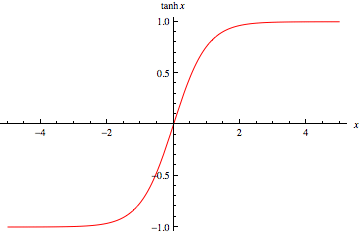
The graph of the hyperbolic tangent function for all real values is:
A. Strictly increasing
B. Strictly decreasing
C. Strictly increasing in the interval [0,∞) and Strictly decreasing in the interval (-∞,0]
D. Strictly increasing in the interval (-∞,0] and Strictly decreasing in the interval [0,∞)
Answer
216.9k+ views
Hint: The hyperbolic tangent function,that is, \[{\text{tanh}}\] function is the ratio of \[\sinh \] function to the \[\cosh \] function. We can find the trend of the graph by giving different values of x and observing the corresponding trend in y value.
Complete step by step answer:
The tanh function or hyperbolic tangent function is the ratio between hyperbolic sine and hyperbolic cosine.
We know that,
$
{\text{sinhx = }}\dfrac{{{{\text{e}}^{\text{x}}}{\text{ - }}{{\text{e}}^{{\text{ - x}}}}}}{{\text{2}}} \\
{\text{coshx = }}\dfrac{{{{\text{e}}^{\text{x}}}{\text{ + }}{{\text{e}}^{{\text{ - x}}}}}}{{\text{2}}} \\
$
Then tanh is given by,
${\text{tanhx = }}\dfrac{{{\text{sinhx}}}}{{{\text{coshx}}}}{\text{ = }}\dfrac{{{{\text{e}}^{\text{x}}}{\text{ - }}{{\text{e}}^{{\text{ - x}}}}}}{{{{\text{e}}^{\text{x}}}{\text{ + }}{{\text{e}}^{{\text{ - x}}}}}}$
For \[{\text{x = 0,tanhx = 0}}\].
As x increases, value of \[{\text{tanhx}}\] also increases,
Also, as x decreases, the value of \[{\text{tanhx}}\] decreases.

So, we can say that the graph of the hyperbolic tangent function is strictly increasing.
Therefore, the correct answer is option A.
Note: It is important to know the graph of the basic functions and how the value varies as x varies. Even though the graph is strictly increasing, the value of the function tends to 1 as x tends to infinity and -1 as x tends to negative infinity. This can be proved by taking the limits,
$
\mathop {\lim }\limits_{x \to \infty } \tanh x = \mathop {\lim }\limits_{x \to \infty } \dfrac{{{e^x} - {e^{ - x}}}}{{{e^x} + {e^{ - x}}}} \\
= \dfrac{{\mathop {\lim }\limits_{x \to \infty } \left( {1 - {e^{ - 2x}}} \right)}}{{\mathop {\lim }\limits_{x \to \infty } \left( {1 + {e^{ - 2x}}} \right)}} \\
= \dfrac{{1 - \mathop {\lim }\limits_{x \to \infty } {e^{ - 2x}}}}{{1 + \mathop {\lim }\limits_{x \to \infty } {e^{ - 2x}}}} \\
= \dfrac{1}{1} \\
= 1 \\
$
Similarly, tanh tends to -1 when x tends to negative infinity. So the becomes almost straight at higher and lower values of x.
Complete step by step answer:
The tanh function or hyperbolic tangent function is the ratio between hyperbolic sine and hyperbolic cosine.
We know that,
$
{\text{sinhx = }}\dfrac{{{{\text{e}}^{\text{x}}}{\text{ - }}{{\text{e}}^{{\text{ - x}}}}}}{{\text{2}}} \\
{\text{coshx = }}\dfrac{{{{\text{e}}^{\text{x}}}{\text{ + }}{{\text{e}}^{{\text{ - x}}}}}}{{\text{2}}} \\
$
Then tanh is given by,
${\text{tanhx = }}\dfrac{{{\text{sinhx}}}}{{{\text{coshx}}}}{\text{ = }}\dfrac{{{{\text{e}}^{\text{x}}}{\text{ - }}{{\text{e}}^{{\text{ - x}}}}}}{{{{\text{e}}^{\text{x}}}{\text{ + }}{{\text{e}}^{{\text{ - x}}}}}}$
For \[{\text{x = 0,tanhx = 0}}\].
As x increases, value of \[{\text{tanhx}}\] also increases,
Also, as x decreases, the value of \[{\text{tanhx}}\] decreases.

So, we can say that the graph of the hyperbolic tangent function is strictly increasing.
Therefore, the correct answer is option A.
Note: It is important to know the graph of the basic functions and how the value varies as x varies. Even though the graph is strictly increasing, the value of the function tends to 1 as x tends to infinity and -1 as x tends to negative infinity. This can be proved by taking the limits,
$
\mathop {\lim }\limits_{x \to \infty } \tanh x = \mathop {\lim }\limits_{x \to \infty } \dfrac{{{e^x} - {e^{ - x}}}}{{{e^x} + {e^{ - x}}}} \\
= \dfrac{{\mathop {\lim }\limits_{x \to \infty } \left( {1 - {e^{ - 2x}}} \right)}}{{\mathop {\lim }\limits_{x \to \infty } \left( {1 + {e^{ - 2x}}} \right)}} \\
= \dfrac{{1 - \mathop {\lim }\limits_{x \to \infty } {e^{ - 2x}}}}{{1 + \mathop {\lim }\limits_{x \to \infty } {e^{ - 2x}}}} \\
= \dfrac{1}{1} \\
= 1 \\
$
Similarly, tanh tends to -1 when x tends to negative infinity. So the becomes almost straight at higher and lower values of x.
Recently Updated Pages
JEE Atomic Structure and Chemical Bonding important Concepts and Tips

JEE Amino Acids and Peptides Important Concepts and Tips for Exam Preparation

Electricity and Magnetism Explained: Key Concepts & Applications

Chemical Properties of Hydrogen - Important Concepts for JEE Exam Preparation

JEE Energetics Important Concepts and Tips for Exam Preparation

JEE Isolation, Preparation and Properties of Non-metals Important Concepts and Tips for Exam Preparation

Trending doubts
JEE Main 2026: Application Form Open, Exam Dates, Syllabus, Eligibility & Question Papers

Derivation of Equation of Trajectory Explained for Students

Hybridisation in Chemistry – Concept, Types & Applications

Understanding the Angle of Deviation in a Prism

Understanding Collisions: Types and Examples for Students

How to Convert a Galvanometer into an Ammeter or Voltmeter

Other Pages
JEE Advanced Marks vs Ranks 2025: Understanding Category-wise Qualifying Marks and Previous Year Cut-offs

Understanding Atomic Structure for Beginners

Ideal and Non-Ideal Solutions Explained for Class 12 Chemistry

Degree of Dissociation: Meaning, Formula, Calculation & Uses

Understanding Electromagnetic Waves and Their Importance

Understanding the Electric Field of a Uniformly Charged Ring




